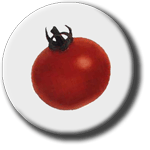In Praise of the Nightshade Family
by Ruth D'Alessandro
I
t’s July, and all thoughts turn to juicy salad vegetables,
so now’s the time to sing the praises of the tomato, and get you all enthusiastic
about ripening and picking them now, or planning to grow lots of zany varieties
next year.
Of all the produce you can grow on your garden or allotment,
tomatoes are probably the most satisfying, followed closely by potatoes. Tomatoes
need a degree of love and care, seed potatoes you merely stick in a manured
trench in March/April, bank up the ridge over them to protect from late frosts
and make sure they’re weeded and watered. It’s well recognised that
home-grown fruit and veg tastes much better than supermarket varieties, but
it’s not until you bite into a tangy-sweet tomato, freshly picked from
the vine and still warm from the sun that you can truly appreciate the difference.

Gardeners DelightFrom a very early age in my parents’ garden, and
even now, I still have a frisson of excitement every time I see a root of potatoes
being dug. The plant above the surface looks yellow, decaying and less than
abundant, but as the fork goes in and lifts those underground treasures to the
surface, together with the funny, wizened little seed potato that started them
all off, I just can’t help feeling that a small miracle of growth has
occurred in my own back yard.
Tomatoes and potatoes, together with aubergines, peppers and
chillies, are members of the mighty Solanaceae family of plants, which numbers
2800 species throughout the world. Most Solanaceae are found in South America,
and were brought to Europe by the early explorers. None of the edible varieties
are frost-hardy, so you’ll need to keep an eye on the weather forecasts.
The Solanaceae also includes the nightshades, from woody to deadly.
You’ll notice that the flowers of tomatoes, potatoes, woody and deadly
nightshades are very similar in shape, and once potatoes have flowered, they
produce a little green inedible fruit that looks just like a miniature tomato.
At the other extreme of edibility, the deadly nightshade (belladonna) berry
looks like a small, black tomato, but it is highly poisonous.
Belladonna (‘beautiful woman’), by the way, gets
its name from the practice in medieval Italy where ladies would take some deadly
nightshade to make their pupils dilate and so appear more attractive. Belladonna
contains hallucinogenic alkaloids, nicotine and atropine, and the pupil dilation
is part of the toxic effect of the plant.
Because of their relationship to such poisonous plants, some
Chinese medical and holistic practitioners recommend that potatoes and tomatoes
should not be eaten, as they contain similar toxins. Try telling that to the
Irish and the Italians.
So, how do you grow these little treasures? Tomatoes first,
although you can grow aubergines, green peppers and chillies in exactly the
same way. Decide what sort of tomato you particularly like, and grow those and
lots of others. This year, I’ve grown nine types of tomato:
• Roma VF:
an Italian plum tomato, fleshy and suitable for cooking.
• Tigerella:
a bit of a novelty, with its stripy yellow and red fruit, but it is delicious
and yields lots of tomatoes.
• Gardener’s Delight:
little sweet cherry tomatoes.
• Sunburst:
miniature yellow plum tomatoes. It’s really worth growing yellow tomatoes,
even though up until recently there has been a bit of consumer prejudice about
them. People tend to forget that the original tomatoes brought over from the
then ‘New World’ were yellow, hence the Italian word for tomato,
‘pomodoro’ - ‘golden apple’. Yellow tomatoes are delicious,
with a more intense sweet/sharp tang than their red relations.
• Tumblers:
great as a patio plant - just put them in tubs and stake them, don’t
pinch out any side shoots and allow them to bush out. One plant will produce
pounds of cherry tomatoes, and will self-stop when it reaches its limits.
• Big Boy:
a beefsteak tomato which should yield fruits weighing a pound each. The plant
needs staking as the fruits get bigger to support them.
• Marmande:
also a lovely big tomato - it’s the one you see most often in Southern
European markets, huge and knobbly and misshapen, and quite delicious.
• Alicante
and Ailsa Craig:
these are your ‘normal’ tomatoes, red, medium sized and flavoursome
if grown in rich compost and fed well.
I always start my tomatoes off from seed at the beginning of
March in the greenhouse. Using potting compost (I must admit that I use commercial
compost for raising seedlings - you can guarantee there are no weed seeds in
it which would otherwise strangle the seedlings), fill some small pots, scatter
over some tomato seeds, and cover them with about 5mm of compost.
If you’re growing aubergines or chilli peppers, these must be in the
greenhouse; green peppers can be grown outside in a sunny, sheltered place like
tomatoes.
I then put about 2mm of vermiculite (tiny water-retaining cellulose-like
pellets that keep moisture and warmth in) on top of the compost, and water it
gently. Place the plants inside a propagator, cover the pots with a sheet of
newspaper, and after four days, peek under the newspaper to see if any seedlings
have come through. If it’s cold, they may take up to three weeks to germinate,
so don’t despair, some warmer weather will waken the seed. Keep the vermiculite
moist, but don’t overwater, as you will rot the seed.
Once your seedlings have appeared, remove the newspaper, and
let them grow. They’ll soon start developing ‘proper’ leaves,
and when they are about 50mm tall, you’ll need to pot them on individually
to bigger pots. I buy whalehide (don’t worry - we didn’t use real
whales) pots from our allotment shop. These are biodegradable and the tomatoes’
roots poke through them, so they can be planted straight into the soil or container,
pot and all, without disturbing the roots.
When your tomatoes are about 200mm high, decide whether you
want to plant them outside in the ground, or in containers, or in the greenhouse
in pots or grow-bags. Only plant outside once you are certain that the last
frost has passed. This is generally the second week in May in southern England,
the beginning of June further north.
Make up a lovely mixture of composts; a bit of commercial all-purpose
compost (using spent stuff from last year to save money), your own black gold
that you will have made yourself in four car tyres, a couple of handfuls of
Blood, Fish and Bone, and some mushroom compost which is very rich and full
of nutrients for tomatoes.
• If you’re growing tomatoes outside, dig holes
and fill them with compost, water it well and plant the tomatoes. Stake them
with 4-ft canes and as the plants grow, tie them to the stake with garden
twine.
• If you’re growing them in the greenhouse or
containers, fill them up with rich compost, and plant, stake and tie as before.
Put them somewhere sunny, as they’re tropical plants at heart, and they’ll
reward you richly.
As your tomatoes grow, and unless you’re growing the bush-like
Tumbler tomatoes, you’ll need to pinch out side shoots. This are little
shoots that grow between the stem of the plant and the main leaves. If you leave
them in, the plant will concentrate on throwing out more leaves than fruit,
and you’ll get a smaller yield. You’ll feel quite brutal pinching
out the shoots, as some of them get quite big and look like they should be part
of the plant, but you’ll be rewarded with more tomatoes if you do. Don’t
pinch out shoots that don’t have leaves, as these are the shoots that
produce fruit.
Water tomatoes generously, consistently. If you let them dry
out and then water them, the fruits will split.
Now, feeding. An elderly organic gardener I know doesn’t
feed his tomatoes; he maintains that as long as they are planted in rich compost
they will have enough nutrients. I maintain that nature needs a bit of help
sometimes, and I shall ask him if I can do a taste-test with one of his tomatoes
and one of mine later on in the year to see which is the more delectable. Watch
this space for the result of the tomato doorstep challenge.
The tomato family is reasonably free of pests, although you
may occasionally get whitefly, especially in the greenhouse. Put a few French
marigolds at the base of each plant, and this will soon clear the whitefly.
If the weather is damp, you may get some powdery mildew which will clear as
the weather gets warmer.
Snails, as I have ranted about before,
have been particularly bad this year, and last year ate nearly all my greenhouse
tomatoes. Be brutal with the gastropods!
You’ll need to feed your tomatoes as soon as ‘the
first truss is set’. This means that you need to watch your bunch of yellow
tomato flowers (truss) (not a chore, as you’ll see all sorts of fascinating
pollinating insects), and when they wither and drop off, leaving a little green
pimple of an embryonic tomato behind, the truss is said to be set. If you’re
going to grow organically, you can use commercial concentrated cow manure (stinky),
seaweed extract (stinky in a sea-ey sort of way) or comfrey liquid (no less
stinky than the others).
You can make your own comfrey liquid, which is very rich in
potassium, by growing your own plants in a spare corner. The roots of the comfrey

Big Boyplant go deep, down to 20ft, and they draw up nutrients and store them in the
leaves. The official variety of comfrey for making fertiliser is Bocking 14,
but any old wild stuff works just as well. Grow the plants, let them flower
(you’ll get those lovely pollinating insects again) and then chop them
down ruthlessly at ground level. Pack leaves and stems into a large watertight
container, and cover with water and some plastic sacking. Allow this all to
rot down for about a month to a brown soup and strain it off. The comfrey you
cut down will have regrown by now and you can cut it again and make some more.
Feed the tomatoes (and indeed any fruiting Solanaceae that you have grown) with
some of the brown soup once a week.
Pray for a sunny summer, and by August, you’ll be rewarded
with a glut of top-notch tangy tomatoes of all shapes and colours, that many
of the top chefs in Britain would swap their Sabatiers for.
Grow some sweet basil plants (use the same rich compost mixture),
then slice some tomatoes onto plates, with an avocado and a mozzarella cheese,
season with salt and black pepper, drizzle over some thick green olive oil,
and some torn basil leaves, and serve with rustic bread. The perfect summer
starter! Or, for summer breakfasts, fry sun-ripened chopped tomatoes in olive
oil with lots of black pepper, and serve on toast.
Recent medical research has shown that an antioxidant in tomatoes,
called lycopene, is instrumental in protecting against certain cancers, and
we should all be eating more tomatoes, raw and cooked. Who needs an excuse to
do that anyway?
See you next month, with a creepy-crawlies special!
June 1998
Penge


